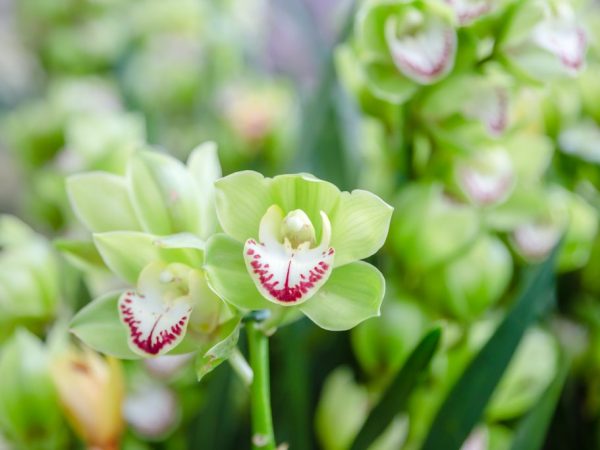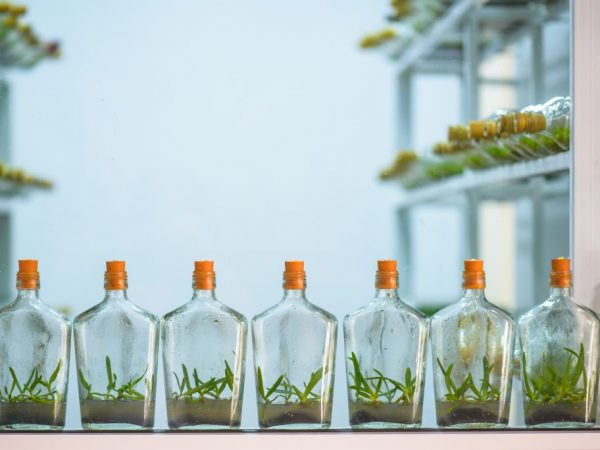Description of the green orchid
Green orchids look exotic. Such flowers grow well in an apartment on a window. The green orchid is a representative of different plant varieties, each of which has its own external characteristics.

Green orchid
Description of the variety
Phalaenopsis and cymbidium orchids are green. Color, size, number of buds, peduncle length depend on the type of plant.
There are such varieties of orchids:
- Phalaenopsis Amalfi. Its petals have a yellow-green hue, a purple lip. The flowers are large, from 4 to 7 buds are formed on one high erect peduncle.
- Phalaenopsis Violacea alba. Small flowers. At the base, the petals are purple, but then turn into a light green color. The buds develop on thin, creeping shoots. Flowering arrows are produced in an amount from 1 to 10, each developing 1-6 buds.
- Cymbidium Sessa Green Beauty. The flowers are large, with bright green petals and a yellow lip with purple or red spots. Shoots are strong, erect. 5-20 buds develop on one high peduncle. Cymbidium leaves are long and pointed.
Phalaenopsis green varieties also include Bowring Cattleya, Luteous Forb, Lady's Slipper, Sunrise Goldmour. Their flowers are muted, soft shades.
Growing
The green orchid is unpretentious to external conditions, it takes root well in apartments. For her, you need to choose a place with good lighting.
Landing
Orchids have aerial roots; in the wild, they do not grow in the ground, but attach to other plants. Garden stores sell special clear plastic orchid pots. They have a small volume and many drainage holes at the bottom.
The substrate for orchids is crushed and nutritious wood and coconut fiber. The substrate must be purchased from flower shops.
Planting seeds
It is imperative to buy green orchid seeds from trusted manufacturers so as not to get on low-quality goods.
Seed material is sterilized with bleach before planting in the substrate. The liquid is poured into a small container, the seeds are thrown there, shaken well and left for 10 minutes. The seeds are not germinated in the soil, but in a special water mixture. To prepare it, prepare:
- 1 liter of distilled water;
- 8 g agar agar;
- 10 g of glucose and fructose;
- 1.5 g of nitrogen-phosphate-potassium fertilizers;
- root-forming stimulant;
- litmus test.
0.5 l of water is boiled, added to non-glucose, fructose and agar. The mixture is stirred until the components are completely dissolved. The second 0.5 liters of water also need to be boiled, removed from the heat, 5 drops of stimulant and fertilizer are added. The pH of the mixture should be 4.2-5.2: in a more acidic or alkaline environment, the seeds will not germinate.
The liquid is poured into sterilized glass jars with a narrow neck, about 30 ml each. Then the jars are sealed with cotton wool and gauze and sterilized in a water bath. The material is left for 5 days. If mold appears inside the containers, orchid seeds cannot be placed there. Then seeds are poured into jars with the mixture.
Under normal conditions, seeds germinate within a year.Then young seedlings are removed from the liquid, washed with water and planted in a prepared sterilized substrate.

Planting green orchid seeds
Planting from a scion
Phalaenopsis orchids are propagated by shoots. It is important to properly separate the young shoot from the adult plant. The appendix is cut off with a secateurs or sharp scissors treated with alcohol. Places of cuts are sprinkled with coal.
The roots on the shoot are grown even before separation from the mother plant. To do this, it is wrapped in wet moss. Moss requires constant moisture and lighting. The plant is moved to a warmer place.
When the roots grow at the shoot, they are planted in a pot:
- Sterilized drainage stones (expanded clay, pebbles) are placed on the bottom of the pot.
- The shoot is placed in the center of the pot, the root collar is placed at the level of the edge of the container. The roots are evenly spaced throughout the container.
- The soil is poured into the pot in layers, supporting the process with your hand.
The planted shoot is first watered in 2-3 days. Subsequent watering is carried out after the soil has dried, after 5-6 days.
A full-fledged plant from a shoot is formed for 2-3 years. At the same time, the rules of care must be followed.
Care rules
Provide optimal conditions for normal growth and regular flowering:
- daytime temperature - 18-20 ° С, at night - about 15 ° С;
- bright diffused lighting, protection from direct ultraviolet rays, shading at noon;
- moderate watering with filtered water at a temperature of 25 ° C;
- spraying flower leaves with special feeding.
Top dressing is prohibited during dormancy and flowering. The plant is transplanted as it grows (about once every 2 years). An orchid requires urgent transplantation in case of root diseases and deterioration of the substrate.
Diseases and pests
Improper care will lead to plant disease. Common orchid diseases:
- burns from direct exposure to ultraviolet radiation;
- wilting and leaf fall due to overheating or hypothermia within 10 hours;
- drying of roots due to low humidity, rotten roots and leaves due to high humidity;
- cessation of flowering due to lack or excess of fertilizers.
The easiest way to prevent problems is by taking proper care of the flower. The parts of the plant damaged by the disease are removed. The diseased plant is placed in a shaded place, they begin to water it moderately, adding sugar to the water every time. If the root system is damaged, new roots are grown and a flower is transplanted.
Improper care reduces the immunity of the plant, it becomes vulnerable to pests. Orchids are most often attacked by whiteflies, spider mites, aphids, mealy worms, and scale insects. Insecticides help get rid of them.
Conclusion
Green orchids need proper light and moderate moisture. Sterility during planting and proper care are the main measures for the prevention of diseases and the key to a regular and rich flowering.


